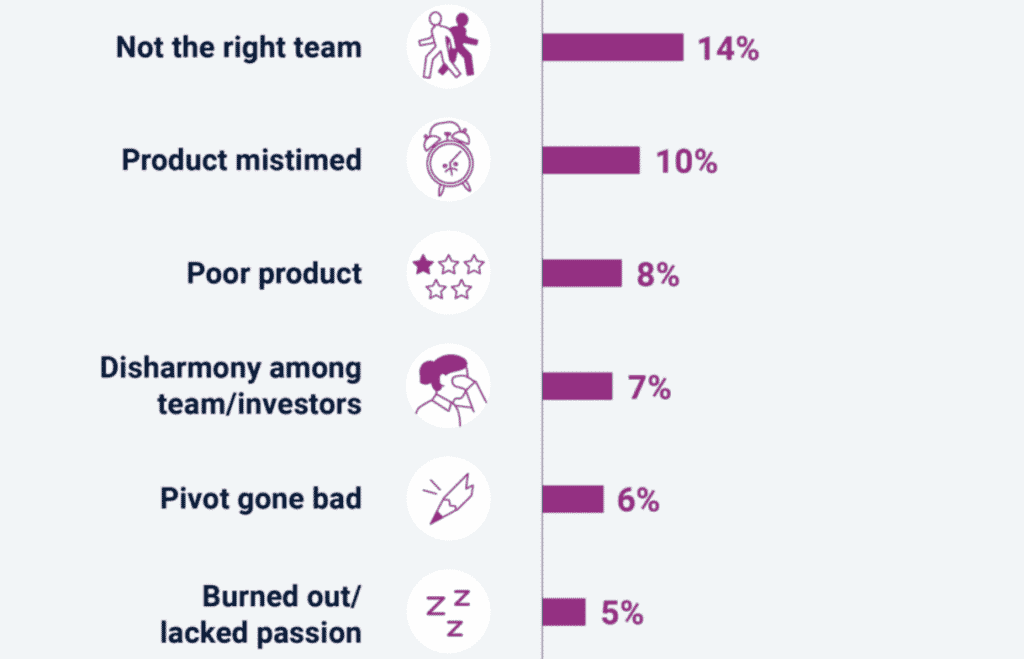When building a startup, time is the great unknown.
You may be able to find an opportunity, validate it, and reach product/market fit in three months. Or, it might take years.
Investor Andrew Chen calls this time variable Time to Product/Market Fit (TTPMF). And unfortunately, a startup’s Time to Product/Market Fit is limited. He explains:
“You want to get to the point where your product is working, and if you can’t get there within the first 1-2 years of your company’s existence, you generally run out of money or your team falls apart.”
All tech workers can earn good living wages. In the face of failure, and great uncertainty, it’s easy for them to be lured away by other jobs or startup opportunities, and as a result, for the team to implode. Sadly, it’s the fate of roughly one quarter of startups.

Evaluating Your Founding Team
To evaluate the odds of success, it’s a good idea for members of your founding team to clarify their expectations, and how they imagine things playing out.
Sit down with the members of your founding team. Answer the following questions independently. Then share back to discuss.
- What’s my main reason for starting a company?
- What lifestyle am I trying to create for myself?
- What day-to-day work would I like to create for myself?
- How much money do I need per month to sustain myself? How many months could I sustain myself at my current rate of spending?
- Are we bootstrapping—funding growth through sales—or do we intend to seek funding?
- What milestones are we expecting to reach in order to agree to double down on our commitment? What milestones do we believe will help us raise capital?
- What would be another opportunity that, if it were to come along, would be extremely difficult to pass up on?
- How much risk am I willing to accept?
- Are we seeking disruption, or are we doing incremental innovation?
- What’s the maximum opportunity cost that I’m willing to invest?
- Are there things in my life (e.g. family, personal projects, etc) that could change the answers I just gave?
Building a successful business is a marathon, not a sprint. It’s critical to be aligned on the goals and expectations, and to create positive momentum to keep the core team committed.
To make sure that you’re all in sync, have really frank discussions on the type of business that you intend to create (e.g. unicorn vs indie), your cash requirements, your risk tolerance, and the shortest runway among the founders. Agree on a plan.
But What if We Have Different Goals or Visions?
Founding teams will never be entirely aligned.
If founders have different goals, or timelines, the exercise will help them determine if the divergences are likely to become more problematic later in the journey. If the founders differ in terms of responsibilities, or the strategies they’d like to use to reach the goals (e.g. bootstrapping vs raising capital), the exercise will simply lead to more clarifying discussions.
The individual answers should help members of the founding team better understand the goals and real-life situations of their business partners. This exercise is more about flagging and anticipating issues than shutting down a partner relationship.
More on the Founding Team
- How to Find The Right B2B Business Opportunities For Your Team in 2024
- [ Interview ] GSoft Co-Founder Simon De Baene on Scaling Product Innovation From $0 to $100M ARR
- How to Leverage Your Team And Advisors to Build Credibility in B2B
Download the First 4 Chapters Free
Learn the major differences between B2B and B2C customer development, how to think about business ideas, and how to assess a venture’s risk in this 70-page sampler.
Working on a B2B Startup?
Join our free email course to learn all you need to know:


